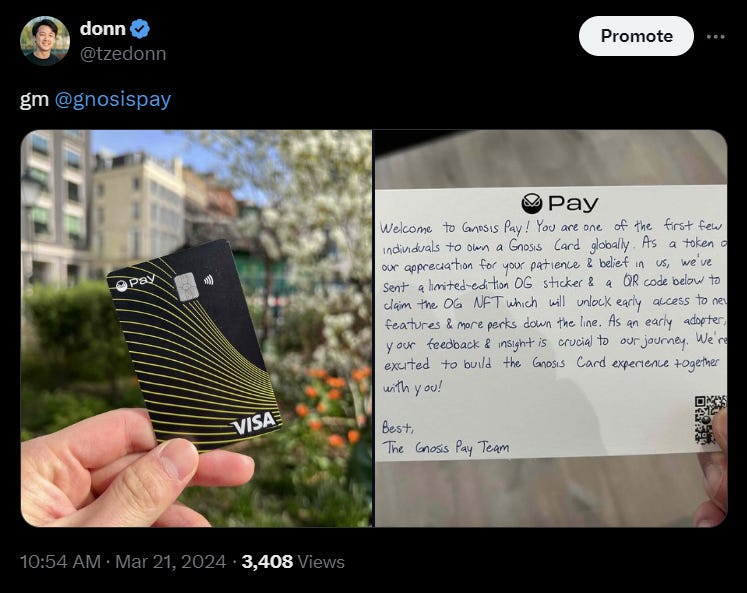For those that have been following me for awhile, you would know that I’m incredibly bullish on crypto payments *on a long enough time horizon*. Been waiting to try out GnosisPay since the EthCC announcement last year… and it’s finally here!
How the Gnosis Pay card works
Every Gnosis Pay card is a Gnosis Safe wallet (a smart account wallet) and a Visa debit card.
You top up your card by depositing GBPe (or EURe in Europe) on the Gnosis L1 to your Safe wallet. GBPe is a GBP-backed stablecoin issued by Monerium, a MiCA-compliant e-money issuer.
When you tap your Visa debit card to buy a £3 coffee, the terminal sends a message to the merchant acquirer who sends a message to Visa who sends a message to Gnosis Pay’s proprietary processing engine that checks the balance and other criteria. If all is good, Gnosis Pay signs a tx which sends GBPe from your Safe wallet to Monavate’s wallet. Monavate settles the fiat leg, and you get your coffee.
But wait, how can Gnosis Pay sign a transaction for you and take money out of YOUR Safe wallet without you signing? The answer is that there’s actually a Roles module1 on the Safe smart account which gives GnosisPay the authority to sign transactions.
But what happens if Gnosis Pay gets hacked? There is a daily spending limit set by the user, and funds can only be sent to a specific address (i.e. Monavate’s).
How do you top up your Gnosis Pay card?
In its currently early beta stage, Gnosis Pay primarily caters to crypto-native early testers, because getting GBPe can be quite difficult.
I only had spare USDC on Base, so I used Jumper, a Bridge and DEX aggregator powered by LiFi to convert USDC on Base to xDAI on Gnosis, because (i) a direct conversion to GBPe doesn’t work likely due to lack of liquidity and (ii) you need xDAI for gas on Gnosis.
I then converted my xDAI for GBPe through CowSwap which routes it through the GBPe-x3CRV Curve pool. In the end, I received 20% less than I should have (on a $20 transaction) due to lack of on-chain liquidity, but all else was free (tx fees ~0, “off-ramp fees” ~0).
(Note: Providing some alpha here from the Gnosis Pay team… they will start providing tens of millions of GBPe liquidity very soon)
It’s slightly easier if you already have funds (xDAI) on Gnosis chain but let’s be honest, 95% of people who hold crypto have no idea what DAI is and 99.9% have never used Gnosis chain.
Alternatively, you could do a zero-fee on-ramp through Monerium. You do a bank transfer in GBP and receive GBPe 1-1 on Gnosis chain. Based on MiCA regulations, e-money issuers cannot charge a fee for e-money issuance, hence you will always get a 1-1 exchange rate, similar to depositing GBP into Wise.
So… What’s the point of all of this?
The most obvious question is: Why would I on-ramp GBP through Monerium into my Safe to spend it, when I can just use my Monzo or Lloyds debit card?
My take is that we’re still incredibly early and this is just a taste of what could be in store for crypto payments.
A good analogy is Skype which provided both traditional telephone calls and VoIP through the internet. As the internet matured, all Skype users only made calls through the internet.
The same is true for Gnosis Pay. Currently you’re still paying through Visa rails (with extra steps). But, as cryptodollar (USDC) acceptance and adoption increases, merchants will start accepting GBPe hence bypassing card networks and saving ~2% in fees.
I think things can even more exciting when all G20 currencies are tokenised on-chain, and you can automatically use LiFi to find the cheapest route to convert your USDC to GBPe to pay for something in the UK, for example.
Stablecoins are now e-money in the EU. I’ve been screaming from the rooftops for the past 12 months, but the GBP you have on your Wise account and the GBPe token you bought from Uniswap are legally the same thing, e-money, backed 1-1 with fiat GBP.
Also, crypto enables two things: (i) Self-custody and (ii) Composability… But why does that matter?
One key point a lot of people are missing is that self-custody means Crypto x Fintech devs do not touch your funds and hence are purely tech providers who do not need to get multiple regulatory approvals before launching a simple Fintech product. This increases the speed of innovation and drastically reduces time to market.
Composability also means devs do not need to pay additional “integration fees” to Jumper, Bungee, etc. and that you can route your USDC → GBPe trade in the cheapest way across all liquidity pools. Instead of getting charged a 2% FX fee, you could just pay 10-20bps on Uniswap and spend in any tokenised local currency.
Fundamentally, blockchains are the “Internet of Value”. Making payments through stablecoins is like using physical cash, but digital. We remove intermediaries and make the entire process pretty much free. Much cheaper vs the Visa / Mastercard-duopoly that charges merchants ~2%.

Payments is difficult. Let alone crypto payments. But I think the high level idea is there — stablecoins and crypto assets are meant to transfer value through blockchains. Ultimately the goal is simple — to remove intermediaries and make payments cheaper.
DM me to discuss payments!
There are two Safe modules that come with every GnosisPay Safe. The “Roles” module has 4 configs (token used, daily limit, recipient address (ie Monavate’s address), role delegation (to GnosisPay). The “delay” module ensures non-card tx has a 3 min delay.







Interesting read!
Very good explanation! Whilst you say the main value of this will come in the future as
we transition into merchants accepting
GBPe, I'd argue the most attractive bit here really is that self-custody! Eliminating that risk of getting 'locked out' of your own money from a bank/exchange.